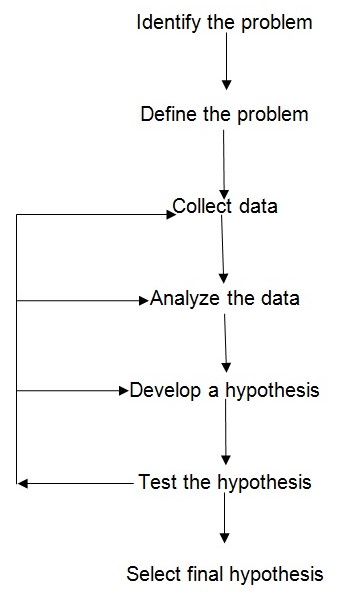Introduction
A fire investigation should be taken as a methodical line of enquiry whose purpose is not only to determine the cause of the fire, but how and where it started. Chisum and Turvey observe that the scientific method is the most effective and commonly used method of fire investigations (364). According to Cote the process refers to “the methodical quest of knowledge that involves the identification and setting up of the problem, the collection of data via observation and experiment as well as the formulation and testing a theory supported by data (hypothesis)” (334). The scientific method is inclusive and comprehensive with important steps that this paper attempts to discuss.
Steps involved in the scientific method
Recognizing the need
Realizing that there is a fire problem is the first step to be resolved which is always evident because a notification has already been given to the investigator and requested to investigate about the incident. The role and responsibility that should be fulfilled by the investigator determine the exact nature of the problem a particular investigator needs to address. For example, an investigator may receive a call for a residential house on fire on James Street.
Define the problem
On arriving at the scene, an investigator is required to define the problem that needs to be solved. Often this involves determining the origin as well as the cause of that fire. There is also the need to determine the role of the surroundings in spreading the fire and whether there are any casualties. This step is important as the information gathered helps the investigator to apply the available resources more effectively. An example is when an investigator conducts a comprehensive assessment of the scene and realizes that the fire originated from the kitchen.
Collecting data
After defining the problem, the investigator will evaluate the scene and collect all the relevant information that will help in finding the solution to the problem. The data collected is empirical data that can be verified (Chandler, 130). An investigator is therefore required to document the data properly. An example of data collection is when an investigator notes burnt pots with food. The investigator questions the owner of the house and confirms the answers from other members of the family. The investigator further examines the burned pots and notes down his/her observation. The investigator may further try to connect the pattern followed by the fire noting the observations.
Analyzing data
While analyzing the data, an investigator examines the evidence as objectively as possible to assess its meaning and ultimately determine a possible theory that can be supported by the data (IAAI, 18). The important data are considered while discarding any irrelevant information. The investigators are supposed to use their knowledge, expertise, experience, and training full to deliver effective outcomes. An example for this step is to begin analyzing the data collected to determine the patterns around the kitchen. This might call for a review of the food contents and their rapidness in catching fire including the cooking oil used.
Developing hypothesis
The outcome of data analysis is the development of a hypothesis or a theory that seem to be supported by the data and which can explain the systematic events of the incident. Through inductive reasoning, the investigator will be attempting to solve the earlier defined problem. Therefore, the step will involve identifying where and how the fire occurred, and anybody who could have been responsible. In case of any doubts on the witness statements of fire behavior, further analysis should be carried out to identify the reason behind the difference. For example the investigator may realize that the fire occurred due to negligence of the house lady who left the heater on.
Testing the hypothesis
This step involves taking the facts of the incidents and doing a critical and careful challenge to all facts known. The hypothesis can only be accepted when it stands up to all factual challenges, otherwise it is discarded. If this happens, the investigator should go back and collect more data, reexamine and re-analyze all the information to develop another viable hypothesis. The new hypothesis is also subjected to thorough and careful test to determine whether it can withstand the challenges. As an example, the investigator may realize that the fire could not have spread so fast if there was somebody in the kitchen. Further examination and analysis reveals that there had been power failure for some time and nobody was in the kitchen when the incident occurred.
Selecting final hypothesis
After completing the methodical investigation through the scientific method, integrating empirical data, deductive and inductive reasoning, and the origin and causes of the incidents are identified and confirmed, it is important to develop a final hypothesis. This final theory is considered as the exact scenario or incident that occurred. An example is when an investigator is fully convinced that, the switch had been left on and the heater burned the kitchen table which caused the oil in the pan to explode spreading the fire all over the kitchen and eventually into other rooms.

Conclusion
Scientific method has been the most commonly used method in fire investigation due to its comprehensive coverage of the issues associated with such incidents. It is a systematic approach that identifies all the possible causes, consequences, and implications to develop a scenario that could be similar to the actual incident. This knowledge helps in realizing how such incident could be avoided in the future.
Works Cited
Chandler, Russell K. Fire Investigation. Mason, OH: Cengage Learning, 2009. Print.
Chisum, William and Turvey, Brent. Crime reconstruction. San Diego, CA: Academic Press, 2006. Print.
Cote, Arthur. Fundamentals of Fire Protection. Sudbury, MA: Jones & Bartlett Learning, 2004. Print.
International Association of Arson Inves. Fire Investigator: Principles and Practice to NFPA 921 and 1033. Sudbury, MA: Jones & Bartlett Publishers, 2010. Print.